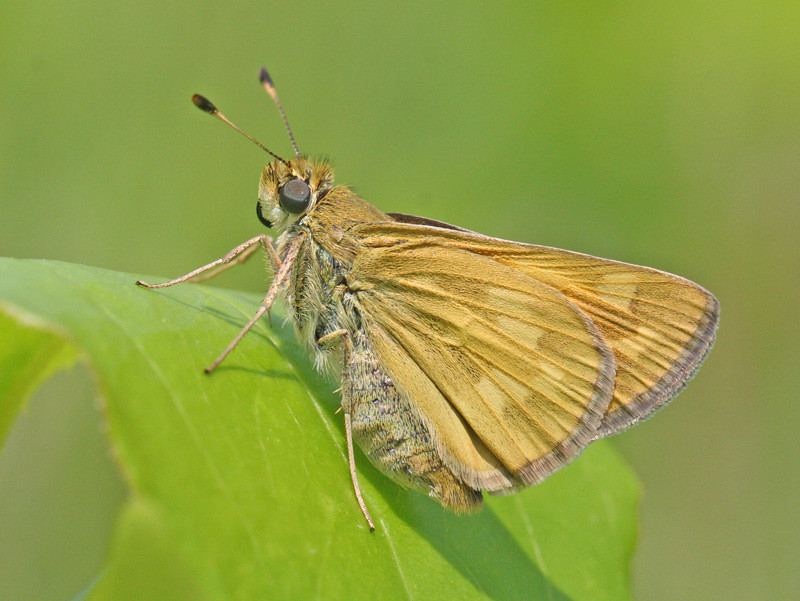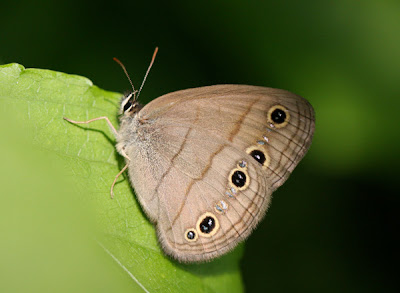Summer is known as the best time of year for butterfly diversity. With warm temperatures and blooming flowers (e.g. joe-pye-weed, beebalm, and milkweeds), butterflies can be extremely abundant. During this time, the species diversity of butterflies is very high; in mid-July, it is not uncommon to easily find 20-30 butterfly species in a single meadow. As a result of this high diversity and abundance of brightly-colored species, many "butterfliers" wait until this prime time to go looking for these insects.
Although summer is often considered the best season for butterflies, many unique species show up around late spring. Many of these species only fly for a short time period, so by the time the summer butterflies emerge, these interesting spring species are no longer around. Unlike summer, where large, flower-filled meadows and gardens seem to be hotspots, spring butterflies prefer woodlands and grassy meadows or shrubby areas.
Although summer is often considered the best season for butterflies, many unique species show up around late spring. Many of these species only fly for a short time period, so by the time the summer butterflies emerge, these interesting spring species are no longer around. Unlike summer, where large, flower-filled meadows and gardens seem to be hotspots, spring butterflies prefer woodlands and grassy meadows or shrubby areas.
A meadow with warm-season grasses, greenbrier (Smilax), and meadowsweet (Spiraea) is perfect for spring butterfles.
The only downside to finding butterflies during the spring is that they rarely sit still. Since there are few flowers blooming for the butterflies to get nectar, the butterflies do not sit still for very long. However, if flowers such as northern dewberry (Rubus flagellaris) are blooming, the butterflies may congregate around the flowers.
Here are some interesting late spring butterfly species that are currently are flying or will be emerging very soon. If you see these species, please report them to the Eastern Pennsylvania Phenology Project.
Many of the common spring butterflies are classified as "skippers" a group of small, plain butterflies that are commonly found in grassy areas. The butterfly pictured above is a duskywing, which is a type of skipper. This species is most likely a Wild Indigo Duskywing, a common species of open areas. However, there is the possibility that this is a Columbine Duskywing, a little-known species that is virtually identical to the Wild Indigo. Due to the fact that these species are so similar, it is possible that the Columbine Duskywing, although considered rare now, may be more common than researchers currently know. These Wild Indigo-type Duskywings are just beginning to emerge in northeastern Pennsylvania.
This butterfly, a Dreamy Duskywing, is a common butterfly of late spring and early summer. As a caterpillar, Dreamy Duskywings eat the leaves of birches, aspens, and willows, so the adults are commonly found in open meadows or fields near forests where these trees grow. Unlike Wild Indigo Duskywings, a fairly large skipper, Dreamy Duskywings are very small and often avoid detection due to this size as well as their quick flight. This species is very similar to the Sleepy Duskywing, a species that flies a few weeks earlier and is mostly gone by the time Dreamy Duskywings emerge.
Another "large" skipper is the Northern Cloudywing. The cloudywing is similar to the duskywings, but has a different wing shape, often sits with its wings partway open (whereas duskywings often sit with wings fully opened), and does not have as much patterning on the wings. This species can be found in woodlands or open areas. Although this species will begin to emerge during the coming weeks, it will stick around throughout part of the summer.
Yet another brown skipper, the Cobweb Skipper is a very interesting late-spring species. Unlike the previously mentioned species, the Cobweb Skipper belongs to a group of skippers known as grass skippers, a large group of small butterflies. While many of these species are found throughout the summer, some species (including the Cobweb) only occur for a few weeks in late May and early June. The Cobweb Skipper relies on bluestem grasses (Andropogon and Schizachyrium), so it is almost always found in fields or meadows where these plants grow. Unfortunately, good meadows with these necessary grasses are being lost to development, and the butterfly population is falling as well. Although this species can be quite common at a good location, such locations can be difficult to find.
Indian Skippers are often found in the same places as Cobweb Skippers: upland meadows with bluestem grasses. The Indian Skipper also only occurs for a few weeks around the end of May and the beginning of June. This species is also declining due to a loss of habitat, so finding stable populations is extremely important. Since this and the previous species have such short flight periods and are very dependent on rainfall amounts and other meteorological patterns, they are important indicators of climate change and varying weather patterns.
A final butterfly of late spring is the ubiquitous Little Wood-Satyr. These medium-sized brown butterflies are commonly found along wooded edges, fields, yards, and roadsides. The wood-satyr is not a skipper like the previous species and behaves differently. Little Wood-Satyrs often sit on a sunny perch and allow close observation. Wood-satyrs also fly much slower than skippers, making them easy to follow and observe. This species is currently very abundant in many habitats and can number in the hundreds over a small area in suitable habitat.








No comments:
Post a Comment